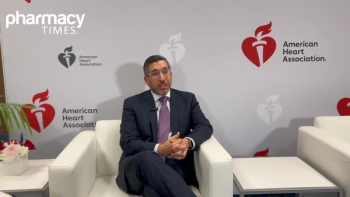
Pediatric Amoxicillin Dosing: A Guide for Indication-Based Dose Selection
Amoxicillin is a favorable choice for outpatient use in pediatric patients given its relatively narrow spectrum of activity and palatable formulation.
Amoxicillin, an aminopenicillin ß-lactam antibiotic, is the most commonly prescribed oral antibiotic in the outpatient setting in the United States, accounting for 162 prescriptions per 1000 persons in 2024.1 Although amoxicillin is heavily relied upon across the age spectrum, it is a particularly popular choice in the treatment of common bacterial infections, including those of the respiratory, urinary, or integumentary systems, in pediatric patients.
It is a favorable choice for outpatient use in pediatric patients given its relatively narrow spectrum of activity and palatable formulation. Compared to other commonly utilized outpatient antibiotics, amoxicillin has one of the narrowest spectrums of activity. It is active against predominantly gram-positive organisms, namely Streptococcus and Enterococcus spp., but does have some activity against select gram-negative organisms, including non-ß-lactamase-producing isolates of Escherichia coli and Haemophilus influenzae. This relatively narrow spectrum is often sufficient for a number of community-acquired infections while avoiding unnecessary coverage, and thus selective pressure, for more resistant pathogens.
When considering pediatric patients, palatability is an important consideration to ensure medication adherence. Amoxicillin oral liquid is commonly available with both fruit and bubblegum flavoring, which may be more acceptable to children compared to solid oral dosage forms or other antibiotic suspensions that lack flavoring or have an anecdotally bitter taste.
Pharmacist Confidence With Pediatric Prescribing
When it comes to pediatric prescriptions, reported rates of pharmacist comfort evaluating these prescriptions vary widely, with one survey reporting that only 1 in 5 community pharmacists felt ‘extremely comfortable’ in doing so, and another 1 in 5 felt outright uncomfortable.2 Even for a medication as highly dispensed as amoxicillin, this trend holds true. When asked to evaluate a theoretical amoxicillin prescription, only 54% of those community pharmacists surveyed correctly affirmed that the dosing was appropriate.2
Understanding the differences between regimens for this population is imperative for any pharmacist, given that pediatric patients are more likely to have preventable medication errors as well as serious harm from said errors.3 In addition to patient safety, it is important to understand appropriate amoxicillin dosing for the purpose of antimicrobial stewardship, as improper dosing can create selective pressure for antimicrobial resistance. Given the prevalence of pediatric amoxicillin prescribing, as well as the importance and perceived discomfort associated with its dosing, this article aims to clarify appropriate amoxicillin dosing for common outpatient pediatric ailments.
Standard vs High-Dose Amoxicillin
Amoxicillin is a drug of interest because its dose is dependent on the microbe it is targeting and the indication for which it is being prescribed. Historically, in pediatric patients, amoxicillin dosing was 45 mg/kg/day in divided doses, known as “standard dosing.” Currently, however, many indications for pediatric amoxicillin use require the utilization of a “high dose” regimen, which is 80 mg/kg/day to 90 mg/kg/day in divided doses.
Penicillin resistance in Streptococcus pneumoniae is the driving force behind the use of high-dose amoxicillin. In 1998, prior to the rollout of the 7-valent pneumococcal vaccine (PCV-7), 24% of pneumococcal isolates associated with invasive disease in the US were non-susceptible to penicillin, a number that was predicted to rise to over 40% by 2004.4 To combat this, PCV7 was developed and introduced in 2000.
Additionally, the use of high-dose amoxicillin was adopted for common S. pneumoniae-induced illnesses. When looking at S. pneumoniae, the minimum inhibitory concentration (MIC) cutoff for high versus standard amoxicillin dosing is 2 mcg/mL. Isolates with a penicillin MIC below 2 mcg/mL could be treated with the historical standard dosing (45 mg/kg/day), whereas isolates with a penicillin MIC greater than or equal to 2 mcg/mL should be treated with high-dose amoxicillin (90 mg/kg/day) to overcome resistance.
Although the introduction of PCV7 and its subsequent iterations has reduced penicillin resistance rates in S. pneumoniae to almost half of what they were in 1998, penicillin resistance remains a concern clinically, especially in the era of vaccine hesitancy and reduced routine vaccination rates.5 Today, high-dose amoxicillin is often universally utilized for infections in which S. pneumoniae may be implicated to ensure proper coverage of S. pneumoniae isolates with intermediate resistance, since this is usually not tested in the outpatient setting. The most notable indication thus excluded from the use of empiric high-dose amoxicillin is bacterial pharyngitis, which is most often caused by Streptococcus pyogenes (group A Streptococcus, GAS).
Understanding MIC Targets and Dosing Principles
Just as indication informs dose selection, it also informs dosing frequency. For most infections in which high-dose amoxicillin would be indicated, the total daily dose of 90 mg/kg/day is divided into 3 doses/day (TID, or Q8H dosing). This applies to indications such as community-acquired pneumonia and sinusitis, although inclusion of clavulanate acid may be needed for an expanded spectrum of activity in the latter. TID dosing allows for optimization of amoxicillin’s antibacterial activity.
Amoxicillin’s antibacterial action is time-dependent, which means its activity is dependent on the amount of time that its concentration at the site of infection is above the pathogen’s MIC. The goals for time above MIC are specific for each infection/drug combination. For S. pneumoniae and penicillin, the goal is for drug levels to remain above the MIC for 30% to 50% of the time, which corresponds to bacteriostatic and bactericidal activity, respectively. The serum half-life of amoxicillin is only 1 to 1.5 hours, which means that it must be dosed more frequently to achieve a goal time above MIC. Dividing the high-dose regimen into TID dosing allows amoxicillin to achieve proper time above the MIC, including for S. pneumoniae isolates with an MIC of 2 mcg/mL.
Exceptions to High-Dose TID Amoxicillin
Acute Otitis Media
TID dosing certainly accounts for most amoxicillin indications, but it is important to mention 2 notable exclusions to the 90 mg/kg/day divided TID regimen. The first exclusion is acute otitis media (AOM). AOM is most often caused by S. pneumoniae, Haemophilus influenzae, and Moraxella catarrhalis. Therefore, because S. pneumoniae is potentially implicated, the high-dose amoxicillin regimen of 90 mg/kg/day would still be most appropriate.
However, AOM is in its own category of amoxicillin dosing due to its unique pharmacokinetic properties related to the site of action in this infection. Interestingly, amoxicillin has a substantially longer half-life in the middle ear fluid (3-6 hours compared to 1-1.5 hours in the serum) due to its slower rate of clearance.6 This does not change the goals for time above MIC, but it does make that goal significantly easier to achieve. Because the half-life of amoxicillin in middle ear fluid is 3 times as long as it is in the serum, we are able to administer doses divided twice daily and still achieve this goal. Less frequent dosing is advantageous, as it is known to improve medication adherence.
Although utilizing high-dose amoxicillin combats potential resistance in S. pneumoniae, it does not overcome any potential resistance in H. influenzae or M. catarrhalis, the other 2 pathogens most often associated with AOM. Both H. influenzae and M. catarrhalis can be ß-lactamase producers, which would require the addition of a ß-lactamase inhibitor, such as clavulanic acid, to make amoxicillin effective. ß-lactamase production in H. influenzae is variable but highly expressed in M. catarrhalis.
Pharyngitis
Pharyngitis is most often viral in nature, but when it is secondary to a bacterial pathogen, Streptococcus pyogenes is the main offender. Whether or not a case of pharyngitis is caused by GAS is determined by a rapid antigen detection test, which may be completed in a matter of minutes in the outpatient setting. In the case of GAS pharyngitis, amoxicillin is the recommended drug of choice.7 Though other bacterial pathogens can be the culprit of non-streptococcal pharyngitis, there is no proven benefit to empirically covering them because, unlike GAS, they do not carry the risk of leading to serious complications like rheumatic fever or glomerulonephritis if left untreated.7 The preferred amoxicillin dose for pharyngitis is the historic, standard dose of 50 mg/kg/day divided into 1 or 2 doses per day. Because the bacterial target is S. pyogenes, penicillin resistance of S. pneumoniae is not a concern, and the high-dose regimen is not required.
Conclusion
As medication experts, community pharmacists play a vital role in the care of their patients. Amoxicillin is one of the most prescribed antibiotics in the outpatient setting, so it is essential to be well-versed in its wide variety of uses and respective dosing regimens. Understanding the distinction between high-dose (90 mg/kg/day) and standard-dose (40-45 mg/kg/day) amoxicillin is key to identifying inappropriately dosed prescriptions and minimizing contributions to antibiotic resistance. High dose regimens should be used when S. pneumoniae could be a contributing pathogen to combat potential intermediate resistance in this bug. Dosing frequency of this regimen is related to the site of infection, and amoxicillin’s half-life at that site, to optimize the antibiotic’s time above the microbe’s MIC. Although the appropriate dosing split for AOM is twice daily, other infections will be accompanied by prescriptions split 3 times daily.
REFERENCES
Outpatient antibiotic prescriptions—United States, 2024. CDC. Accessed November 18, 2025.
https://www.cdc.gov/antibiotic-use/media/pdfs/2024-Annual-Report-508.pdf Brown SW, Oliveri LM, Ohler KH, Briars L. Identification of errors in pediatric prescriptions and interventions to prevent errors: a survey of community pharmacists. J Pediatr Pharmacol Ther. 2019;24(4):304-311. doi:10.5863/1551-6776-24.4.304
Cowley E, Williams R, Cousins D. Medication errors in children: a descriptive summary of mediation error reports submitted to the United States pharmacopeia. Curr Ther Res. 2001;62(9):627-640. doi:10.1016/S0011-393X(01)80069-2
Kyaw MH, Lynfield R, Schaffner W, et al. Effect of introduction of the pneumococcal conjugate vaccine on drug-resistant Streptococcus pneumoniae. N Engl J Med. 2006;354(14):1455-1463. doi:10.1056/NEJMoa051642
Gordon KA, Biedenbach DJ, Jones RN. Comparison of Streptococcus pneumoniae and Haemophilus influenzae susceptibilities from community-acquired respiratory tract infections and hospitalized patients with pneumonia: five-year results for the SENTRY antimicrobial surveillance program. Diagn Microbiol Infect Dis. 2003;46(4):285-289. doi:10.1016/s0732-8893(03)00087-7
Olney K, Howard J, Stahl D, Vidwan NK. Guidance for antibiotic interchange during amoxicillin suspension shortage. Updated January 2023. Accessed November 18, 2025.
https://louisville.edu/medicine/departments/pediatrics/research/cahrds/KYAbxAwareness/antibiotic-interchange-for-outpatients-during-amoxicilin-suspension-shortage Shulman ST, Bisno AL, Clegg HW, et al. Executive summary: clinical practice guideline for the diagnosis and management of Group A streptococcal pharyngitis: 2012 update by the Infectious Diseases Society of America. Clin Infect Dis. 2012;55(10):1279-1282. doi:10.1093/cid/cis847
Newsletter
Stay informed on drug updates, treatment guidelines, and pharmacy practice trends—subscribe to Pharmacy Times for weekly clinical insights.















































































































































































































